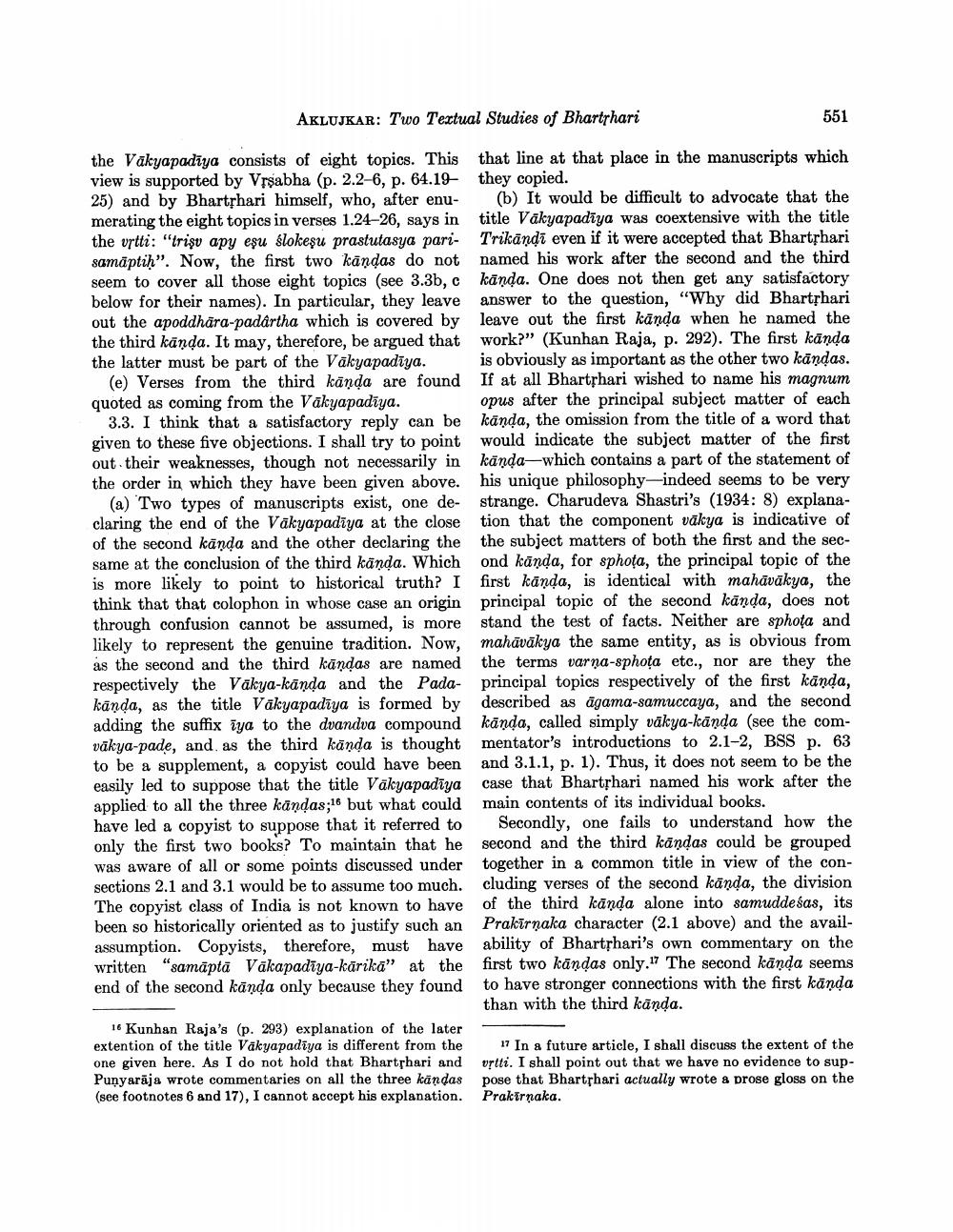Book Title: Two Textual Studies Of Bhartrhari Author(s): Ashok Aklujkar Publisher: Ashok Aklujkar View full book textPage 5
________________ AKLUJKAR: Two Textual Studies of Bhartyhari 551 the Vakyapadīya consists of eight topics. This that line at that place in the manuscripts which view is supported by Vrsabha (p. 2.2-6, p. 64.19, they copied. 25) and by Bhartshari himself, who, after enu- (b) It would be difficult to advocate that the merating the eight topics in verses 1.24-26, says in title Vākyapadīya was coextensive with the title the vrtti: "rişu apy esu ślokeşu prastutasya pari- Trikāndi even if it were accepted that Bhartshari samāptih". Now, the first two kandas do not named his work after the second and the third seem to cover all those eight topics (see 3.3b, c kānda. One does not then get any satisfactory below for their names). In particular, they leave answer to the question, "Why did Bhartrhari out the apoddhāra-padartha which is covered by leave out the first kända when he named the the third kāņda. It may, therefore, be argued that work?” (Kunhan Raja, p. 292). The first kanda the latter must be part of the Vakyapadiya. is obviously as important as the other two kāndas. (e) Verses from the third kānda are found If at all Bhartphari wished to name his magnum quoted as coming from the Vākyapadiya. opus after the principal subject matter of each 3.3. I think that a satisfactory reply can be kānda, the omission from the title of a word that given to these five objections. I shall try to point would indicate the subject matter of the first out their weaknesses, though not necessarily in kanda—which contains a part of the statement of the order in which they have been given above. his unique philosophy-indeed seems to be very (a) Two types of manuscripts exist, one de- strange. Charudeva Shastri's (1934: 8) explanaclaring the end of the Vākyapadiya at the close tion that the component vākya is indicative of of the second kānda and the other declaring the the subject matters of both the first and the secsame at the conclusion of the third kända. Which ond kända, for sphoța, the principal topic of the is more likely to point to historical truth? I first kānda, is identical with mahāvākya, the think that that colophon in whose case an origin principal topic of the second kānda, does not through confusion cannot be assumed, is more stand the test of facts. Neither are sphoța and likely to represent the genuine tradition. Now, mahāvākya the same entity, as is obvious from as the second and the third kändas are named the terms varna-sphoța etc., nor are they the respectively the Vakya-kānda and the Pada- principal topics respectively of the first kānda, kānda, as the title Vākyapadīya is formed by described as āgama-samuccaya, and the second adding the suffix īya to the dvandva compound kānda, called simply vākya-kānda (see the comväkya-pade, and as the third kända is thought mentator's introductions to 2.1-2. BSS p. 63 to be a supplement, a copyist could have been and 3.1.1, p. 1). Thus, it does not seem to be the easily led to suppose that the title Vākyapadīya case that Bhartphari named his work after the applied to all the three kandas;16 but what could main contents of its individual books. have led a copyist to suppose that it referred to Secondly, one fails to understand how the only the first two books? To maintain that he second and the third kāndas could be grouped was aware of all or some points discussed under together in a common title in view of the consections 2.1 and 3.1 would be to assume too much. cluding verses of the second kānda, the division The copyist class of India is not known to have of the third kānda alone into samuddeśas, its been so historically oriented as to justify such an Prakīrnaka character (2.1 above) and the availassumption. Copyists, therefore, must have ability of Bhartshari's own commentary on the written "samäptă Vakapadīya-kärika" at the first two kändas only.17 The second kända seems end of the second kända only because they found to have stronger connections with the first kända than with the third kānda. 16 Kunhan Raja's (p. 293) explanation of the later extention of the title Vakyapadiya is different from the 17 In a future article, I shall discuss the extent of the one given here. As I do not hold that Bharthari and vitti. I shall point out that we have no evidence to supPunyarāja wrote commentaries on all the three kändas pose that Bharthari actually wrote a prose gloss on the (see footnotes 6 and 17), I cannot accept his explanation. Prakirnaka.Page Navigation
1 ... 3 4 5 6 7 8 9 10 11 12 13 14 15 16 17
